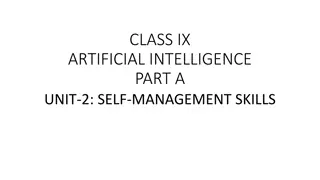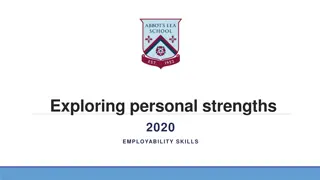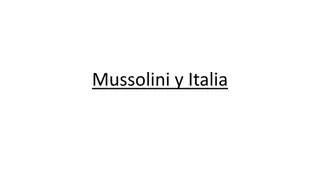Strengths and Weaknesses of Italian Educational System
The Italian educational system exhibits both strengths and weaknesses, with a focus on vocational training, legislative actions, and enhancing citizenship skills. The system emphasizes basic education alongside specialization, aiming to prepare students for the workforce. Legislative decrees have been introduced to strengthen the relationship between schools and the labor market, promoting cooperation through initiatives like the School-Work Alternation Project and the dual system.
Download Presentation

Please find below an Image/Link to download the presentation.
The content on the website is provided AS IS for your information and personal use only. It may not be sold, licensed, or shared on other websites without obtaining consent from the author.If you encounter any issues during the download, it is possible that the publisher has removed the file from their server.
You are allowed to download the files provided on this website for personal or commercial use, subject to the condition that they are used lawfully. All files are the property of their respective owners.
The content on the website is provided AS IS for your information and personal use only. It may not be sold, licensed, or shared on other websites without obtaining consent from the author.
E N D
Presentation Transcript
Contents 1. Rules of law 2. Strenghts 3. Weaknesses 4. Observations IIS Assteas sede Oliveto Citra (SA) Italy 2
1/1 Rules of law The Italian educational and vocational training system has recently been the object of several legislative actions. a) Presidential Decree 87/2010 and the following Guidelines for the transition to the new system of vocational schools. b) Legislative Decree 61/2017. c) Regional Law 20/2012 about the apprenticeship training in Campania Region. d) Legislative Decree 81/2015, concerning the regulation of job contracts in Italy, with particular reference to Chapter V Apprenticeship . IIS Assteas sede Oliveto Citra (SA) Italy 3
1/2 Rules of law e) 12th of October 2015 Decree of the Ministry of Labor and Social Policy in conjunction with the Ministry of Education, Universities and Research and the Ministry of Economy and Finance, concerning the definition of the training standards of the apprenticeship, according to the article 46 of the Legislative Decree 81/2015. f) Resolution of the Regional Council 522/2016 Guidelines for the professional training: regulation of the training standards of the apprenticeship under the Legislative Decree 81/2015 and the 12th of October 2015 Ministerial Decree. IIS Assteas sede Oliveto Citra (SA) Italy 4
2/1 Strenghts The Italian vocational, educational and training system places emphasis not only on the subjects and skills of specialization, but also on a basic linguistic, mathematical, historical, cultural and social education whose aim is to make students enhance citizenship skills, critical sense and the ability to plan their own life and work autonomously. Altough the percentage of unemployed young people has increased in the last years, Italian students really have a bent for individual enterprise. IIS Assteas sede Oliveto Citra (SA) Italy 5
2/2 Strenghts The legislative decrees mentioned above are a good chance to strengthen the relationship between school and labour market. They introduce two forms of cooperation between school and labour market: i. the School-Work Alternation Project; ii. the dual system (school + apprenticeship contract). These two forms of cooperation between school and labour market are performed in each type of high school. It is important to implement the dual system in technical schools so that the educational and working experience would be an incentive for a polytechnic education. IIS Assteas sede Oliveto Citra (SA) Italy 6
3/1 Weaknesses The main obstacles to the implementation of the dual system and of the school-work alternation are the following. The weak training tradition of the Italian enterprise, above all of the small and/or medium sized companies. Italian entrepreneurs are unprepared to train successfully young workers. They expect that school will carry out all the training activities because in most cases they are not ready to invest their valuable time in the training of students. The school curricula are theoretical and far from both the real world of work and the present demand of the labour market. Actually, they are not based on the skills the young workers are required and/or supposed to have. IIS Assteas sede Oliveto Citra (SA) Italy 7
3/2 Weaknesses The lack of awareness and the very low level of knowledge of both the dual system and the school-work alternation the families and the local public authorities have. IIS Assteas sede Oliveto Citra (SA) Italy 8
4/1 Observations Relating to School-Work Alternation project, Italian experience demonstrates that it works better for vocational and/or technical education than for humanistic and scientific education. School-Work Alternation project offers young people, above all students aged 15 and above, in addition to basic knowledge gained at school, the acquisition of skills expendable in the job market. IIS Assteas sede Oliveto Citra (SA) Italy 9
4/2 Observations The major operative difficulties are a general lack of economic funds for both the teacher s work and for the tutor s work. In addition, another difficulty is to find companies that are ready to invest their valuable time in the training of the students. Companies have recently pointed out a significant reduction of the students knowledge; this means that firms have many difficulties in making students apply the theoretical knowledge they should have learnt at school. IIS Assteas sede Oliveto Citra (SA) Italy 10
4/3 Observations Therefore, students have more difficulties to solve elementary and also complex problems, although they should be able to solve these issues at school before they enter the working world. Moreover, the latest Italian school reform has provided for a drastic reduction of technical subjects and laboratories, above all in technical institutes and professional schools, both in terms of teaching hours and in terms of didactic programmes. IIS Assteas sede Oliveto Citra (SA) Italy 11























